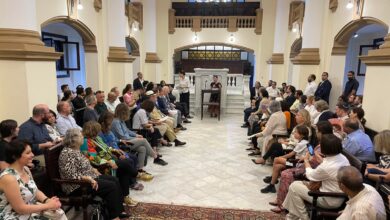Aswan-This week, the Upper Egyptian city of Aswan celebrated both its national day and the 50-year anniversary of the beginning of construction of the famous Aswan High Dam. Celebrations kicked off on 15 January at the foot of the dam, which became a symbol of Egyptian-Russian friendship when it was built in 1971 during the presidency of Gamal Abdel Nasser.
The USSR supported Nasser in constructing the dam–built to regulate the waters of the Nile and guarantee the country against floods–after the US refused to support the project.
The celebration was attended by members of parliament for both Cairo and Aswan, Nasser’s two daughters Hoda and Mona, some of the workers who originally participated in the Dam’s construction, the Russian commercial attaché to Cairo, and a number of young people affiliated with the ruling National Democratic Party.
Later in the evening, there was a street carnival featuring several folkloric bands that came from all over the country, including Alexandria, Luxor, Suez , Sinai and Aswan itself. Band members wore traditional outfits and both girls and boys could be seen dancing–except for the all-male band from Aswan.
Aside from the heavy security presence, the celebration–despite its impressive size–was not felt by most people on the street. Taxi driver Mohammed Abdallah thought the president was visiting: "The army is on the street," said the 63-year-old driver. "This isn’t normal unless the president or prime minister is visiting."
Notably, neither President Hosni Mubarak nor Prime Minister Ahmed Nazif attended the event. "It’s a shame–even Russia sent a representative, while Russian TV came here a month ago to prepare for a big show on the occasion," said one employee from the high dam authority, preferring to remain anonymous.
"Meanwhile, our own president didn’t show up and didn’t send anyone."
When asked about the celebration, 20-year-old boat captain Hamada said he had "no idea" that it was going on.
Even the presenter of Upper Egypt’s official radio station was unsure how old the dam is. She asked her guest, an NDP official, what she wanted to tell the people of Aswan on the occasion, to which the official replied: "I want to congratulate them on the occasion of the 25-year anniversary of the construction of the high dam." The attentive presenter was quick to correct her, pointing out, "It’s 55 years, not 25."
Writer Ahmed Abu Khnegar blamed the incident on an education system that doesn’t teach the difference between one place in Egypt and another. "The system wants to kill our memory. Young people don’t know when the dam was built, why and by whom. History textbooks are the same all over Egypt. They don’t consider the geographical differences," said Abu Khnegar, who attends the street carnival every year.
The construction of the High Dam began in 1960. It was officially inaugurated in 1971 at a cost of $1 billion, much of which was provided by the former USSR. The dam stores 160 billion cubic metres of water, and the reservoir behind it–dubbed Lake Nasser–stretches some 350km into Egypt and 150km into Sudan.
The Aswan High Dam was not the first dam to be built across the Nile at Aswan. In 1898, the British occupying authorities built a dam in roughly the same location, inaugurated in 1902, which failed to dam the river efficiently. This earlier dam cannot compare to the High Dam, however, which is 3,600 meters long and 980 meters wide at its base. The dam is 111 meters high and 40 meters wide at the top. The body of the dam consists of 43 million cubic metres of concrete, iron and other building materials.
Since its construction, the High Dam has saved Egypt from floods that had threatened the country’s agriculture with destruction. It has also supplied the country with almost 70 billion cubic meters of water during several years of drought from 1979 to 1988. It has augmented the amount of available agricultural land to almost 1.5 million feddans due to the increased availability of water, while its power plant provides some 10 percent of Egypt’s electricity supply.
Not all aspects of the dam have been positive, however. The annual flooding of the Nile that took place before the dam’s construction used to deposit a rich layer of soil across the river’s flood plain, which used to flush the salt in the soil out into the Mediterranean Sea–a process that ended with the dam’s construction.




